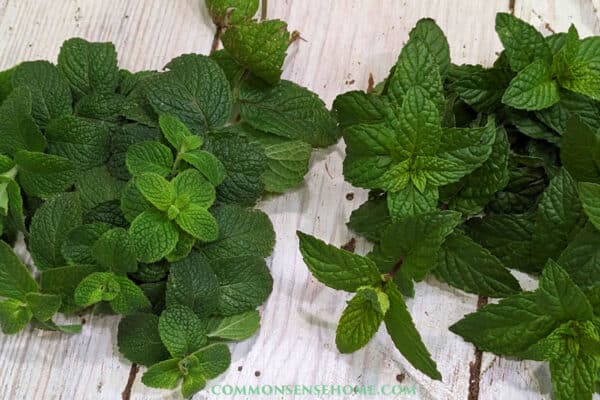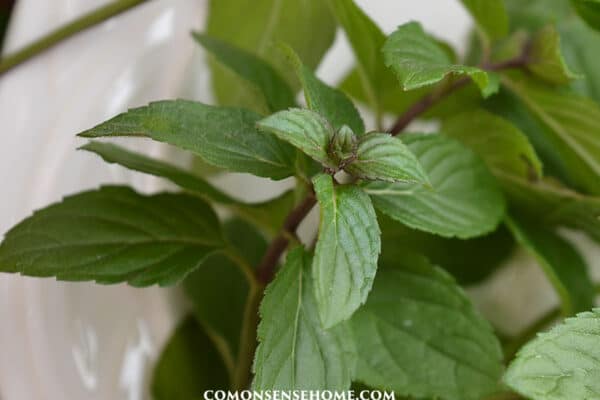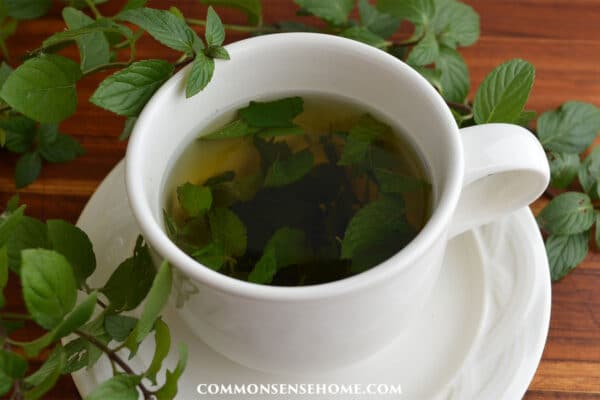How to Use Mint Leaves for Food, Medicine, & More
The distinctive flavor and properties of mint leaves make them a welcome addition in the kitchen and apothecary. Mint plants (genus Mentha) are easy to grow, inside or out. Fresh or dried, try mint leaves for recipes, aromatherapy, beauty treatments, upset stomach, clearing congestion, reducing fevers, and so much more.

The genus Mentha comprises at least 25 species, including peppermint and spearmint. The different species will hybridize and integrate naturally.
Peppermint has broad, dark green, lance shaped leaves. They are roughly toothed with reddish veins and have a slight fuzz. The purple flowers wrap around the stem.
Spearmint grows taller than peppermint. The somewhat serrated, more roundish, stemless leaves are soft and lighter green in color than peppermint. The leaves have a rounded base and feature a line of hairs along the underside. The purple flowers grow in dense spikes at the tips of the stems.
See “How to Grow Mint Plants (with Tips for Starting Cuttings)” for growing tips.
Using Mint in the Kitchen
Mint leaves make an excellent ingredient in many recipes, from main dishes to desserts. Mints not only add flavor, they improve nutrition and digestion.
- Infused Water and Beverages:
- Add a handful of fresh mint leaves to your water for a burst of flavor and a cooling sensation.
- Create mint-infused lemonades, iced teas, or cocktails for a delightful twist.
- Freeze mint leaves with water or tea in an ice cube tray to make mint ice cubes.
- Salads:
- Toss mint leaves into green salads, fruit salads, or grain bowls to add a refreshing and aromatic element.
- Combine mint with feta cheese and watermelon for a unique and summery salad.
- Desserts:
- Garnish desserts like ice cream, sorbet, or chocolate dishes with finely chopped mint leaves.
- Make mint-flavored desserts, such as mint chocolate chip cookies or mint-infused chocolate truffles.
- Sauces and Dips:
- Blend mint into yogurt to create a refreshing tzatziki sauce for Mediterranean dishes.
- Mix mint into homemade salsa or chutney for a zesty kick.
- Try mint pesto with roast meat, fish, or vegetables.
- Hot and Cold Soups:
- Enhance both hot and cold soups by sprinkling on a small amount of chopped mint just before serving. Mint pairs exceptionally well with pea soup or cucumber gazpacho.
Uses Around the Home
- Aromatherapy:
- Set out a bowl of fresh mint leaves for a natural air freshener.
- Dry mint leaves and use them in potpourri or sachets for a long-lasting fragrance.
- Insect Repellent:
- Crush mint leaves and rub them on your skin to help repel insects. You can also place mint leaves around your home to deter pests.
- DIY Beauty Treatments:
- Mix crushed mint leaves with yogurt or honey for a refreshing face mask that can help soothe and rejuvenate the skin.
- Add mints to your bath to calm your nerves, joints, muscles, and lungs.

Medicinal Uses of Mint
Plants in the mint family have many health benefits. Both Spearmint and peppermint owe their medicinal properties to mint essential oils, including menthol. This is what gives mint its strong aroma. They are full of vitamins and minerals including calcium, magnesium, potassium, sodium, iron, niacin, phosphorus, thiamine, selenium, riboflavin, vitamins A and C.
Peppermint (Mentha piperita) and spearmint (Mentha spicata) are “official”, but other mint species have similar medicinal properties. Field mint (M. arvensis), and European horsemint (M. longifolia) are some examples.
Energetically mint is both warming and cooling. It tends to be warming when taken internally, but is cooling to the respiratory system. It's also cooling to muscles when used topically.
Mints are generally considered safe, with few contraindications. The plant's attributes are best extracted in water, which makes a mint tea or “infusion” the best way to enjoy it.
Mint’s Actions
- Digestive
- Antispasmodic
- Carminative
- Bitter
- Anti-emetic
- Antimicrobial
- Diaphoretic
- Nervine
- Stimulant
- Analgesic

What is Mint Good For?
Using mint in herb blends improves the taste tolerance of the other herbs. Mint can be used for the cardiovascular, nervous, digestive, urinary and reproductive systems.
- Digestive Aid
- Chew on fresh mint leaves or sip mint tea to ease nausea and upset stomach. Mint relaxes tension in the digestive tract. This can help relieve bloating, gas and colic, cramps and diarrhea.
- A clinical study has shown peppermint to be effective against irritable bowel syndrome. Mint also relieves the nausea associated with pregnancy and motion sickness.
- Headache Relief
- Inhale the aroma of crushed mint leaves or apply a diluted mint oil to your temples to alleviate headaches.
- Respiratory Health
- Steep mint leaves in hot water and inhale the steam to help clear nasal passages and soothe respiratory discomfort.
- Fever Reducer
- For fevers, combine mint with elderflowers in equal parts for an infusion. Drink this as hot as you can tolerate, sometime before bed. Helpful against the first stages of a viral infection.
- Oral Health:
- Create a homemade mouthwash by steeping mint leaves in water. The antimicrobial properties of mint can help freshen breath.
- Use powdered mint leaves or mint essential oil in homemade tooth powder blends.
- Mood Enhancer
- Combine mint leaves with equal parts rose petals and St. John’s wort for depression and melancholy. Use to make an herbal tea.
- Muscle Soother
- Infuse mint leaves and arnica in oil and make a soothing muscle rub salve.
Peppermint Tea
A simple mint tea can be enjoyed hot or cold, from fresh or dried mint. For fresh mint leaves, heat the water for tea, then add as much fresh mint as you desire to 8-12 ounces of water. Allow to steep for at least 15 minutes, strain and drink.
For dry mint leaves, use about 1-2 teaspoons of the dry herb to 8-12 ounces of water. Allow to steep for at least 15 minutes, strain and drink. For a cold infusion, simply allow the infusion to chill, then add ice as desired.
In the winter, steep mint leaves directly into hot chocolate for a yummy treat!
Contraindications
Peppermint tends to have greater stimulating properties than spearmint. Both mint tea and tincture are considered safe for general use. Although mint tea is calming and nourishing, too much can actually cause a stomach ache.
Do not use mint if you have inflamed bile ducts, or bile stones.
Always use essential oils with caution. Do not ingest essential oils unless you are under the care of an experienced aromatherapist. Do not use mint essential oil directly on the skin without using a carrier oil. Use with caution on sensitive skin. Keep essential oils away from the eyes and other sensitive membranes.

The Home Apothecary Series
This article is part of the Home Apothecary series. Other articles include:
Building Your Own Home Apothecary
White Willow Bark – Harvesting and Use
Ginger Root Uses & Health Benefits
Soothing Ginger Honey – Natural Remedy for Sore Throat and Coughs
Fennel Seed – Natural Digestive Aid

This article was written by Sylvia Gunther. Sylvia studied under Rosemary Gladstar and earned the distinction of Traditional Herbalist. She then studied Clinical Herbalism through The Herbal Academy, where she continues her life long exploration of herbs.
Sylvia and her husband live in North Central Indiana. Together they raised six beautiful children.




